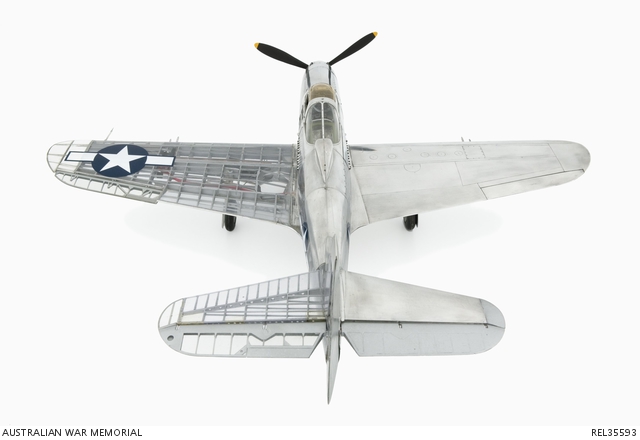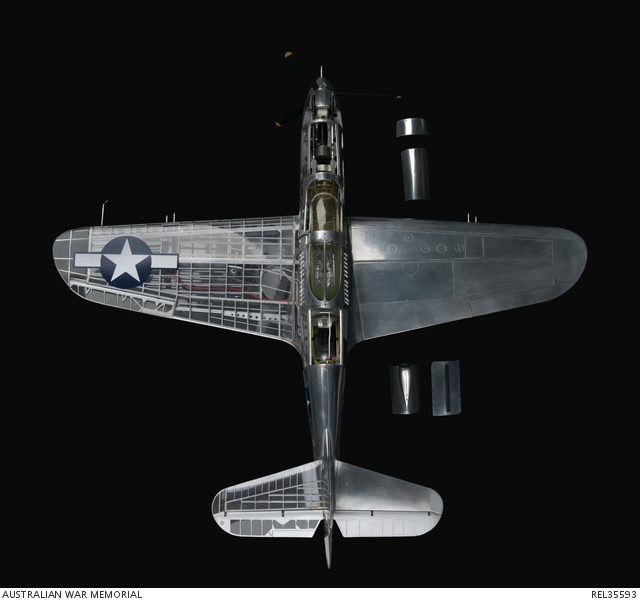| Accession Number | REL35593 |
|---|---|
| Collection type | Technology |
| Object type | Model |
| Physical description | Aluminium, Brass, Plastic |
| Maker |
Glazebrook, Robert |
| Place made | Australia: Queensland, Brisbane |
| Date made | 1998 - 2004 |
| Conflict |
Second World War, 1939-1945 |
Model of a P-39D Airacobra in one sixteenth scale









One sixteenth scale model of a P-39D Airacobra fighter plane made primarily from aluminium and clear plastic. The starboard (right) side is finished with aluminium skinning, while the port side is partially realised in clear plastic to allow the interior detail to be displayed. Most of the port fuselage, tail and tailplane and wing construction is thus visible, and includes piping, electrical connections, machine guns and ammunition, aileron cabling, cockpit instruments, drop tank and the rear mounted engine. Working features include removable side and upper access panels at the nose, opening and latchable cockpit doors, gun bay and engine, a rotating propeller which is linked to and operates the working see-through engine, an opening cockpit door, retractable sprung undercarriage with rubber tyres and a moveable tailplane.
One sixteenth (1:16) scale model of a P-39D Airacobra made by ex-RAAF aircraft fitter Robert Glazebrook. Born at Rockhampton, Queensland on 5 January 1925, Robert James Glazebrook was living in Brisbane when he enlisted on 12 March 1943 and was assigned service number 124010 and the rank of Leading Aircraftsman. He was attached to 36 Transport Squadron a few months after the squadron took delivery of the RAAF's first five DC-3 Dakotas.
The squadron flew regular transport trips to Port Moresby from Townsville (a later detachment was based at Tadji) while a detachment provided pilots and crew flying DC-2s for the Parachute Training Flight, based at Richmond. At war's end they provided transport for occupation troops and returning prisoners of war.
Glazebrook was discharged on 4 April 1946. He had gained an appreciation of aircraft during his service and began to make increasingly detailed models from the 1960s onwards. This example is considered to be the highlight of his modelling career and was completed in the 1990s, taking almost seven years to research and build.
It depicts a P-39D Bell Airacobra, the first major production version of the type. Its major characteristics include a 37mm cannon firing through the nose cone, a configuration which demanded the siting of the Allison V-1710 engine behind the pilot. The shift in the centre of balance necessitated a tricycle undercarriage, the first of its type in the US Air Force. Additional armament comprised two .50 calibre machine guns mounted in the nose and two .30 calibre machine guns in each wing. The Airacobra was designed to operate with a turbocharger but this was omitted in production aircraft, severely limiting its climbing ability, and restricting it to a maximum speed at 4,572 metres (15,000 feet) of 580 kph; the Airacobra took over 9 minutes to reach 6,000 metres (20,000 feet) and in these departments was outclassed by the Japanese Zero and Oscar. At low altitudes, however, the Airacobra's short wing design enabled it to turn with remarkable agility. Airacobras were flown in Australia by both American and Australian squadrons from early 1942.
The Americans, diverted from the Philippines to Australia in late January 1942, formed the 8th Fighter (Pursuit) Group, USAAC which consisted of the 35th, 36th, and 80th Fighter Squadrons; and the 35th Pursuit Group, United States Army Air Corps (USAAC), consisting of 39th, 40th and 41st Squadrons which operated the P-400 (the export version of the P-39). Most of their Airacobras were reassembled at Eagle Farm in Brisbane in late February. The two Groups were variously based in either northern Queensland, Port Moresby or Milne Bay and operated P-39s until replaced by the P-38 Lightning in March 1943. Australian squadrons also flew the Airacobra, with examples being either taken on strength directly from deliveries diverted from the UK, or from reclaimed aircraft damaged on operations by the American squadrons. All RAAF examples were redesignated A53. These were flown from late July 1942 with 23, 24, 82 and 83 Squadrons, RAAF. By November 1943, all the Airacobras had been returned to the 5th Air Force, with the exception of accident write-offs. This model reproduces the examples flown operationally against the Japanese over New Guinea by members of the USAAC from 30 April 1942. Although the model is finished in natural metal, all examples flown from Australia were painted in camouflage schemes.